Shifeng Chen
TARA: Token-Aware LoRA for Composable Personalization in Diffusion Models
Aug 12, 2025Abstract:Personalized text-to-image generation aims to synthesize novel images of a specific subject or style using only a few reference images. Recent methods based on Low-Rank Adaptation (LoRA) enable efficient single-concept customization by injecting lightweight, concept-specific adapters into pre-trained diffusion models. However, combining multiple LoRA modules for multi-concept generation often leads to identity missing and visual feature leakage. In this work, we identify two key issues behind these failures: (1) token-wise interference among different LoRA modules, and (2) spatial misalignment between the attention map of a rare token and its corresponding concept-specific region. To address these issues, we propose Token-Aware LoRA (TARA), which introduces a token mask to explicitly constrain each module to focus on its associated rare token to avoid interference, and a training objective that encourages the spatial attention of a rare token to align with its concept region. Our method enables training-free multi-concept composition by directly injecting multiple independently trained TARA modules at inference time. Experimental results demonstrate that TARA enables efficient multi-concept inference and effectively preserving the visual identity of each concept by avoiding mutual interference between LoRA modules. The code and models are available at https://github.com/YuqiPeng77/TARA.
Contrast-Prior Enhanced Duality for Mask-Free Shadow Removal
Jul 29, 2025



Abstract:Existing shadow removal methods often rely on shadow masks, which are challenging to acquire in real-world scenarios. Exploring intrinsic image cues, such as local contrast information, presents a potential alternative for guiding shadow removal in the absence of explicit masks. However, the cue's inherent ambiguity becomes a critical limitation in complex scenes, where it can fail to distinguish true shadows from low-reflectance objects and intricate background textures. To address this motivation, we propose the Adaptive Gated Dual-Branch Attention (AGBA) mechanism. AGBA dynamically filters and re-weighs the contrast prior to effectively disentangle shadow features from confounding visual elements. Furthermore, to tackle the persistent challenge of restoring soft shadow boundaries and fine-grained details, we introduce a diffusion-based Frequency-Contrast Fusion Network (FCFN) that leverages high-frequency and contrast cues to guide the generative process. Extensive experiments demonstrate that our method achieves state-of-the-art results among mask-free approaches while maintaining competitive performance relative to mask-based methods.
GLAD: Generalizable Tuning for Vision-Language Models
Jul 17, 2025Abstract:Pre-trained vision-language models, such as CLIP, show impressive zero-shot recognition ability and can be easily transferred to specific downstream tasks via prompt tuning, even with limited training data. However, existing prompt tuning methods face two main challenges: (1) In few-shot scenarios, data scarcity often leads to overfitting, making the model sensitive to changes in the input domain. (2) To mitigate overfitting, these methods typically rely on complex task-specific model architectures and sensitive hyperparameter tuning, severely restricting their general applicability. To address these issues, we propose a simpler and more general framework called GLAD (Generalizable LoRA tuning with RegulArized GraDient). We show that merely applying LoRA achieves performance in downstream tasks comparable to current state-of-the-art prompt-based methods. While LoRA is effective and easy to use, it remains susceptible to overfitting in few-shot learning scenarios. To mitigate this risk, we introduce a gradient-based regularization technique. This technique effectively steers the optimization trajectory, encouraging the model to find a more stable parameter region that is robust to variations in data distribution. Through extensive experiments conducted on 15 benchmark datasets, we demonstrate that GLAD outperforms previous tuning approaches in terms of base-to-novel class generalization, image domain generalization, and cross-dataset generalization. The code will be publicly available.
Component Adaptive Clustering for Generalized Category Discovery
Jul 02, 2025



Abstract:Generalized Category Discovery (GCD) tackles the challenging problem of categorizing unlabeled images into both known and novel classes within a partially labeled dataset, without prior knowledge of the number of unknown categories. Traditional methods often rely on rigid assumptions, such as predefining the number of classes, which limits their ability to handle the inherent variability and complexity of real-world data. To address these shortcomings, we propose AdaGCD, a cluster-centric contrastive learning framework that incorporates Adaptive Slot Attention (AdaSlot) into the GCD framework. AdaSlot dynamically determines the optimal number of slots based on data complexity, removing the need for predefined slot counts. This adaptive mechanism facilitates the flexible clustering of unlabeled data into known and novel categories by dynamically allocating representational capacity. By integrating adaptive representation with dynamic slot allocation, our method captures both instance-specific and spatially clustered features, improving class discovery in open-world scenarios. Extensive experiments on public and fine-grained datasets validate the effectiveness of our framework, emphasizing the advantages of leveraging spatial local information for category discovery in unlabeled image datasets.
The Tenth NTIRE 2025 Efficient Super-Resolution Challenge Report
Apr 14, 2025Abstract:This paper presents a comprehensive review of the NTIRE 2025 Challenge on Single-Image Efficient Super-Resolution (ESR). The challenge aimed to advance the development of deep models that optimize key computational metrics, i.e., runtime, parameters, and FLOPs, while achieving a PSNR of at least 26.90 dB on the $\operatorname{DIV2K\_LSDIR\_valid}$ dataset and 26.99 dB on the $\operatorname{DIV2K\_LSDIR\_test}$ dataset. A robust participation saw \textbf{244} registered entrants, with \textbf{43} teams submitting valid entries. This report meticulously analyzes these methods and results, emphasizing groundbreaking advancements in state-of-the-art single-image ESR techniques. The analysis highlights innovative approaches and establishes benchmarks for future research in the field.
Leveraging Contrast Information for Efficient Document Shadow Removal
Apr 01, 2025Abstract:Document shadows are a major obstacle in the digitization process. Due to the dense information in text and patterns covered by shadows, document shadow removal requires specialized methods. Existing document shadow removal methods, although showing some progress, still rely on additional information such as shadow masks or lack generalization and effectiveness across different shadow scenarios. This often results in incomplete shadow removal or loss of original document content and tones. Moreover, these methods tend to underutilize the information present in the original shadowed document image. In this paper, we refocus our approach on the document images themselves, which inherently contain rich information.We propose an end-to-end document shadow removal method guided by contrast representation, following a coarse-to-fine refinement approach. By extracting document contrast information, we can effectively and quickly locate shadow shapes and positions without the need for additional masks. This information is then integrated into the refined shadow removal process, providing better guidance for network-based removal and feature fusion. Extensive qualitative and quantitative experiments show that our method achieves state-of-the-art performance.
IDOL: Instant Photorealistic 3D Human Creation from a Single Image
Dec 19, 2024



Abstract:Creating a high-fidelity, animatable 3D full-body avatar from a single image is a challenging task due to the diverse appearance and poses of humans and the limited availability of high-quality training data. To achieve fast and high-quality human reconstruction, this work rethinks the task from the perspectives of dataset, model, and representation. First, we introduce a large-scale HUman-centric GEnerated dataset, HuGe100K, consisting of 100K diverse, photorealistic sets of human images. Each set contains 24-view frames in specific human poses, generated using a pose-controllable image-to-multi-view model. Next, leveraging the diversity in views, poses, and appearances within HuGe100K, we develop a scalable feed-forward transformer model to predict a 3D human Gaussian representation in a uniform space from a given human image. This model is trained to disentangle human pose, body shape, clothing geometry, and texture. The estimated Gaussians can be animated without post-processing. We conduct comprehensive experiments to validate the effectiveness of the proposed dataset and method. Our model demonstrates the ability to efficiently reconstruct photorealistic humans at 1K resolution from a single input image using a single GPU instantly. Additionally, it seamlessly supports various applications, as well as shape and texture editing tasks.
Dual-Schedule Inversion: Training- and Tuning-Free Inversion for Real Image Editing
Dec 15, 2024



Abstract:Text-conditional image editing is a practical AIGC task that has recently emerged with great commercial and academic value. For real image editing, most diffusion model-based methods use DDIM Inversion as the first stage before editing. However, DDIM Inversion often results in reconstruction failure, leading to unsatisfactory performance for downstream editing. To address this problem, we first analyze why the reconstruction via DDIM Inversion fails. We then propose a new inversion and sampling method named Dual-Schedule Inversion. We also design a classifier to adaptively combine Dual-Schedule Inversion with different editing methods for user-friendly image editing. Our work can achieve superior reconstruction and editing performance with the following advantages: 1) It can reconstruct real images perfectly without fine-tuning, and its reversibility is guaranteed mathematically. 2) The edited object/scene conforms to the semantics of the text prompt. 3) The unedited parts of the object/scene retain the original identity.
DIVE: Taming DINO for Subject-Driven Video Editing
Dec 04, 2024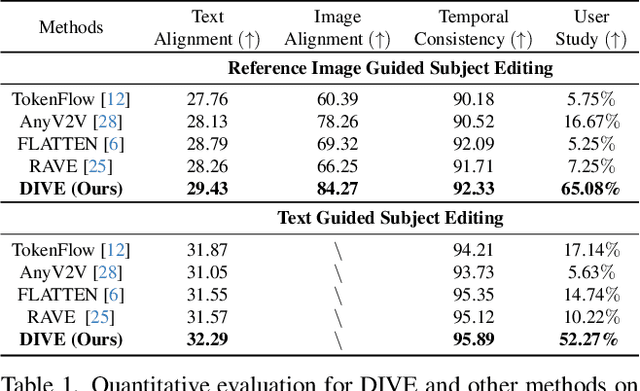

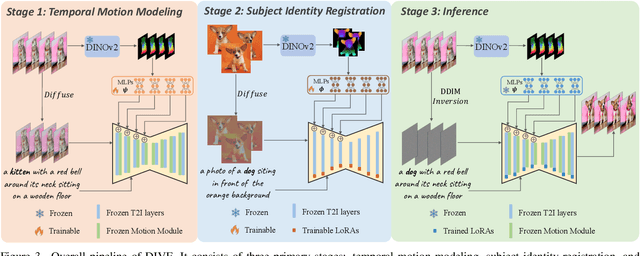
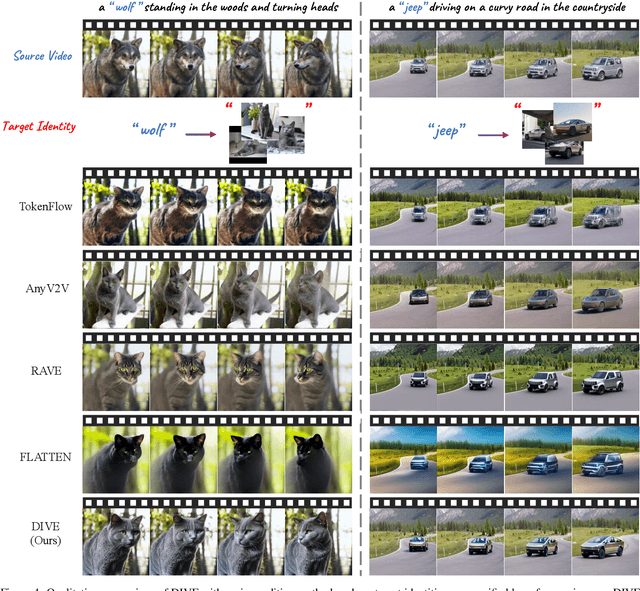
Abstract:Building on the success of diffusion models in image generation and editing, video editing has recently gained substantial attention. However, maintaining temporal consistency and motion alignment still remains challenging. To address these issues, this paper proposes DINO-guided Video Editing (DIVE), a framework designed to facilitate subject-driven editing in source videos conditioned on either target text prompts or reference images with specific identities. The core of DIVE lies in leveraging the powerful semantic features extracted from a pretrained DINOv2 model as implicit correspondences to guide the editing process. Specifically, to ensure temporal motion consistency, DIVE employs DINO features to align with the motion trajectory of the source video. Extensive experiments on diverse real-world videos demonstrate that our framework can achieve high-quality editing results with robust motion consistency, highlighting the potential of DINO to contribute to video editing. For precise subject editing, DIVE incorporates the DINO features of reference images into a pretrained text-to-image model to learn Low-Rank Adaptations (LoRAs), effectively registering the target subject's identity. Project page: https://dino-video-editing.github.io
Feature Augmentation for Self-supervised Contrastive Learning: A Closer Look
Oct 16, 2024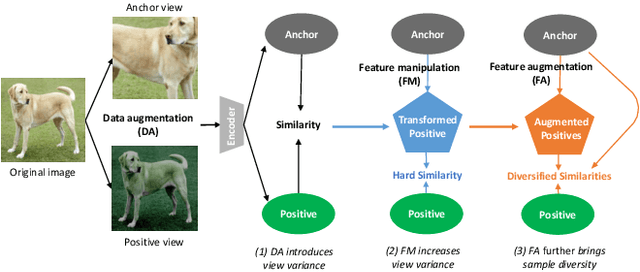

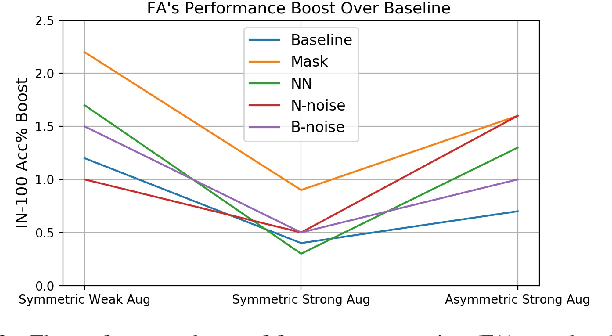

Abstract:Self-supervised contrastive learning heavily relies on the view variance brought by data augmentation, so that it can learn a view-invariant pre-trained representation. Beyond increasing the view variance for contrast, this work focuses on improving the diversity of training data, to improve the generalization and robustness of the pre-trained models. To this end, we propose a unified framework to conduct data augmentation in the feature space, known as feature augmentation. This strategy is domain-agnostic, which augments similar features to the original ones and thus improves the data diversity. We perform a systematic investigation of various feature augmentation architectures, the gradient-flow skill, and the relationship between feature augmentation and traditional data augmentation. Our study reveals some practical principles for feature augmentation in self-contrastive learning. By integrating feature augmentation on the instance discrimination or the instance similarity paradigm, we consistently improve the performance of pre-trained feature learning and gain better generalization over the downstream image classification and object detection task.
 Add to Chrome
Add to Chrome Add to Firefox
Add to Firefox Add to Edge
Add to Edge